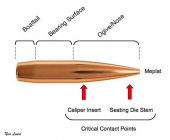Opened two new boxes of 7mm 160 accubond boxes... both because of major discrepancies in base to ogive measurments. First box all over the place... second box trying to get enough in one range to work a load with. Had 26 in the 0.8075 range - those all came from the first box. The next closest range was 0.8125 measure.
Did a 9 shot test at 100 yards. The two highest loads with N165 were 67.2 and 67.5 grains. These two loads combined put 5 shots in a 1/2" group with only a increase in speed by roughly 20fps in the higher load. Went to range yesterday with 6 loads - one using the 0.8075 round and one using the 0.8125 round. Both at 67.3 grains.
First load was comparable to first test. Second load opened up to 1.75" group at same seating depth. Now I only have roughly 15 bullets in the 0.8075 measure. What is the best way to get the 0.8125 rounds to perform - reduce powder to reduce pressure? FPS did increase in second load about 25 fps.
This is really a sad thing that Nosler has no more control over base to ogive measure than this. All the other bullets increase in ogive measure as in these first two groups. Think I may not even load the 15 rounds and just call it quits with Nosler.
EDITED TO ADD: Between the two boxes there were also 5 bullets with the tips broken off. There were a few with serious blemishes in the copper as well.
Did a 9 shot test at 100 yards. The two highest loads with N165 were 67.2 and 67.5 grains. These two loads combined put 5 shots in a 1/2" group with only a increase in speed by roughly 20fps in the higher load. Went to range yesterday with 6 loads - one using the 0.8075 round and one using the 0.8125 round. Both at 67.3 grains.
First load was comparable to first test. Second load opened up to 1.75" group at same seating depth. Now I only have roughly 15 bullets in the 0.8075 measure. What is the best way to get the 0.8125 rounds to perform - reduce powder to reduce pressure? FPS did increase in second load about 25 fps.
This is really a sad thing that Nosler has no more control over base to ogive measure than this. All the other bullets increase in ogive measure as in these first two groups. Think I may not even load the 15 rounds and just call it quits with Nosler.
EDITED TO ADD: Between the two boxes there were also 5 bullets with the tips broken off. There were a few with serious blemishes in the copper as well.
Last edited:











